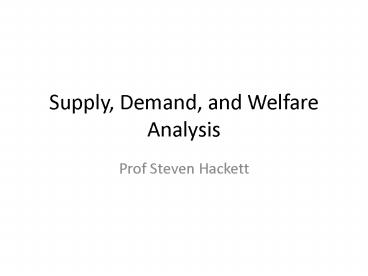Supply, Demand, and Welfare Analysis PowerPoint PPT Presentation
1 / 26
Title: Supply, Demand, and Welfare Analysis
1
Supply, Demand, and Welfare Analysis
- Prof Steven Hackett
2
Competitive Market
- Preconditions for a well-functioning competitive
market include - Large number of buyers and sellers, each small in
size relative to the overall market - No externalities
- No collusion or cartels
- Effective market institution facilitating
exchange, setting price, at low transaction cost - Very low cost entry/exit
- Homogeneous goods and costs (ie, commodities)
3
Demand
- Imagine using a regression model to estimate a
structural demand equation for annual cords of
firewood in Humboldt County - Q 10,000 250P 0.25Pop 20,000Png
0.8Inc - Suppose each coeff is significant, F-stat is
significant, no heteroskedasticity, no
multicollinearity
4
Demand
- To derive a demand curve we need to hold all
non-firewood price RHS variables constant. Lets
evaluate the demand equation above at the mean
value of all the non-firewood price variables - Q 10,000 250P .25130,000 20,0001.20
0.835,000 ? - Q 94,500 250P
5
Demand
- Q 94,500 250P
- To plot this equation as a demand curve we need
to put it into y-intercept form - P 378 0.004Q Inverse demand equation
- (Note For P a bQ, a 378, b 0.004)
6
Demand Curve
P
378
Slope -0.004
Demand
Q
7
Shift in Demand Curve
- What happens to the demand curve in the previous
slide if one of the factors held constant were to
change (e.g., price of natural gas, consumer
incomes, population of Hum Co)? - Re-derive equation for demand curve. The
y-intercept term will be different.
8
Supply
- Imagine using a regression model to estimate a
structural supply equation for firewood in
Humboldt County. - Q 59,700 250P 500Pdiesel 600Wage
- Suppose each coeff is significant, F-stat is
significant, no heteroskedasticity, no
multicollinearity
9
Supply
- To derive a supply curve we need to hold all
non-firewood price RHS variables constant. Lets
evaluate the supply equation above at the mean
value of all the non-firewood price variables - Q 59,700 250P 5005 60012 ?
- Q 50,000 250P
10
Supply
- Q 50,000 250P
- To plot this equation as a supply curve we need
to put it into y-intercept form - P 200 0.004Q
- (Note For P c dQ, c 200, d 0.004)
11
Supply Curve
P
Supply
Slope 0.004
200
Q
12
Shift in Supply Curve
- What happens to the supply curve in the previous
slide if one of the factors held constant were to
change (e.g., price of diesel fuel or wages)? - Re-derive equation for supply curve. The
y-intercept term will be different.
13
Supply Demand Curve
P
Supply
378
Demand
200
Q
14
Equilibrium
- Equilibrium P Q
- 378 0.004Q 200 0.004Q collect like
terms - 178 0.008Q
- Q 178/.008 22,250
- P 289
15
Supply Demand Curve
P
Supply
378
CS
289
PS
Demand
200
Q
22,250
16
Welfare Analysis Consumer Surplus
- Gains from voluntary exchange
- Consumer surplus Represents surplus value or the
gain of getting a bargain when WTP gt P. - Represents area between demand curve and price
line. - With linear S and D, it is a right triangle, and
its area can be calculated as such. - CS ½(378-289)22,250 990,125
17
Welfare Analysis Producer Surplus
- Gains from voluntary exchange
- Producer surplus Basically the same as profit
before fixed costs. P MC gt 0. - Represents area between price line and supply
curve. - With linear S and D, it is a right triangle, and
its area can be calculated as such. - PS ½(289-200)22,250 990,125
18
Welfare Analysis
- Note PS only equals CS here because the supply
and demand curves have the same slope in absolute
value (i.e., b d). - If the model were changed so that b was different
from d, then PS would differ from CS.
19
Optional Using Integrals
Using our simple linear equations, consumer
surplus is given by
q
? (a bq)dq pq
0
What is the solution?
20
Optional Using Integrals
Solving this definite integral yields consumer
surplus
CS q(a bq/2 p)
Where p and q are equilibrium price and
quantity values
21
Optional Using Integrals
CS q(a bq/2 p)
In our model, q 22,250, p 289, a 378,
and b 0.004. Solving the reduced form
equation above should yield the same numerical
value as found earlier.
Where p and q are equilibrium price and
quantity values
22
Optional Using Integrals
Using our simple linear equations, producer
surplus is given by
q
pq - ? (c dq)dq
0
What is the solution?
23
Chapter 3 The Economics of Market Allocation
Solving this definite integral yields producer
surplus
q(p c dq/2)
Where p and q are equilibrium price and
quantity values
24
Optional Using Integrals
PS q(p c dq/2)
In our model, q 22,250, p 289, c 200,
and d 0.004. Solving the reduced form
equation above should yield the same numerical
value as found earlier.
Where p and q are equilibrium price and
quantity values
25
Competitive Equilibrium is Efficient
- With the given supply and demand, one cannot
select a different quantity and produce more
total surplus (CS PS). Thus the competitive
equilibrium is allocatively efficient.
26
Comparative Statics
- One can see how p, q, CS, and PS change when
some non-price factor shifts supply and/or
demand. - In general, an increase in demand (rightward
shift in demand curve) results in a larger
y-intercept value (a), and increases p, q,
CS, and PS. - In general, an increase in supply (rightward
shift in supply curve) results in a smaller
y-intercept value (c). P smaller, q, CS, and
PS larger.

